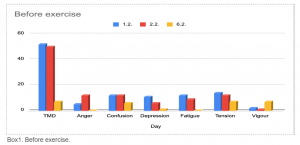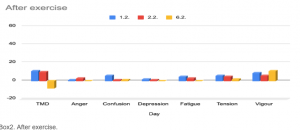Data collection
HRV and sleep duration was collected with an Oura ring. Mood state data was collected with POMS (Profile of Mood States) Questionnaire. For more information about the POMS Questionnaire, see the previous post.
Contextualisation of the past two week’s data
As shown in Box1, these results are from 1st, 2nd, and 6th February. The purpose of exercise was to see how physical activity affects mood and sleep. Exercise included long-distance walking (7-10 km/session) and frequent pilates (60min/session). During the 1st and 2nd February, I was menstruating. In Ojazele et al. (2022) research mood swing was discovered as a symptom overlapping with psycho-emotional, physical, and behavioral symptoms during menstruation. Psycho-emotional symptoms include anger, irritability and depression. Physical symptoms include coldness, paleness, food craving, breast tenderness and digestive changes. Behavioral symptoms include social withdrawal, nocturnal social activity, absenteeism, poor work or academic performance and increased libido. I had all the symptoms stated above and did not want to exercise at all.
The POMS results from the 1st (blue) and 2nd (red) in the Total Mood Disturbance scores are 52 and 50! As shown in Box1, the blue and red pillars are way above the yellow (6th Feb, after menstruation) scores in all other categories except in Vigour. Before any physical exercise, the TMD and other categories showed eye-opening data about the difference of mood states during and after menstruation.

In Box2 the remarkable results of POMS Questionnaire are shown after the exercise. The intense walking or pilates sessions decreased the TMD on the 1st and 2nd to 11 and 10. On the 6th the score went to –8. The scores have fallen in each category, except in Vigour where the scores have risen. Based on these results, intense walking and pilates have positive benefits on moods during and after menstruation.

Sleep
I assumed I was a good sleeper, before I got my Oura ring, I’d fall asleep immediately, stay asleep through the night, then wake up about 8-10 hours later. I thought wrong.
The Oura ring made me aware that while I was getting a good amount of sleep, my sleep quality wasn’t always great.
My HRV was almost always a zigzag line instead of an optimal HRV and I rarely got as much deep and REM sleep as I should.
This data woke me out of my complacency and got me experimenting with all sorts of things like light, temperature, eating schedule, sleep schedule, screen time, to improve my sleep habits.
Ultimately, the Oura ring even helped me learn to love slowing down before bedtime.

Heart rate variability (HRV), which is regulated by your autonomic nervous system, is very useful for evaluating physical fitness and your body’s readiness to perform. Measured in milliseconds (ms), HRV is literally the difference in time between beats of your heart.
Heart rate variability is something I was not familiar with, and I needed a better understanding what it is and why it’s so meaningful.
Broadly speaking, higher HRV is usually an indication of better fitness, according to Oura. As shown in Box3, lower HRV can be found from the previous days (31st Jan and 5th Feb) of exercise. Lower HRV may indicate stress or inconsistent sleep. Static or increased HRV balance may indicate optimal training. However, one of the most important things to realise with heart rate variability is that it is an extremely individualized metric that often differs significantly from one person to another. It can also fluctuate considerably on a day-to-day basis (and throughout the day). The most frequent HRV score for women is 37 (mine was 31 ms). This data was also too small to offer proper correlation.
Sajjadieh et al. (2020) showed in their findings that poor sleep quality is adversely associated with HRV. Sleep duration and HRV parameters had no significant association. My small data shows similar results. Physical activity may keep the total amount of sleep more regular and stable, but it’s the weekends and the fun that ruin the good rhythm!
Summa summarum, there’s no time during the month when physical activity does not have a positive impact on my mood! Poor sleep on the other hand has an impact on HRV.
References
Cao R, Azimi I, Sarhaddi F, Niela-Vilen H, Axelin A, Liljeberg P, Rahmani AM
Accuracy Assessment of Oura Ring Nocturnal Heart Rate and Heart Rate Variability in Comparison With Electrocardiography in Time and Frequency Domains: Comprehensive Analysis. J Med Internet Res 2022;24(1):e27487. doi: 10.2196/27487
Ojezele MO, Eduviere AT, Adedapo EA, Wool TK. 2022. Mood Swing during Menstruation: Confounding Factors and Drug Use. Ethiop J Health Sci. Jul;32(4):681-688. doi: 10.4314/ejhs.v32i4.3. PMID: 35950064; PMCID: PMC9341030.
Oura: An Introduction to Heart Rate Variability, 2022. Available online: https://support.ouraring.com/hc/en-us/articles/360025441974-An-Introduction-to-Heart-Rate-Variability
POMS Questionnaire 2022. Available online: https://www.brianmac.co.uk/poms.htm
Sajjadieh A, Shahsavari A, Safaei A, Penzel T, Schoebel C, Fietze I, Mozafarian N, Amra B, Kelishadi R. 2020. The Association of Sleep Duration and Quality with Heart Rate Variability and Blood Pressure. Tanaffos. Nov;19(2):135-143. PMID: 33262801; PMCID: PMC7680518.

